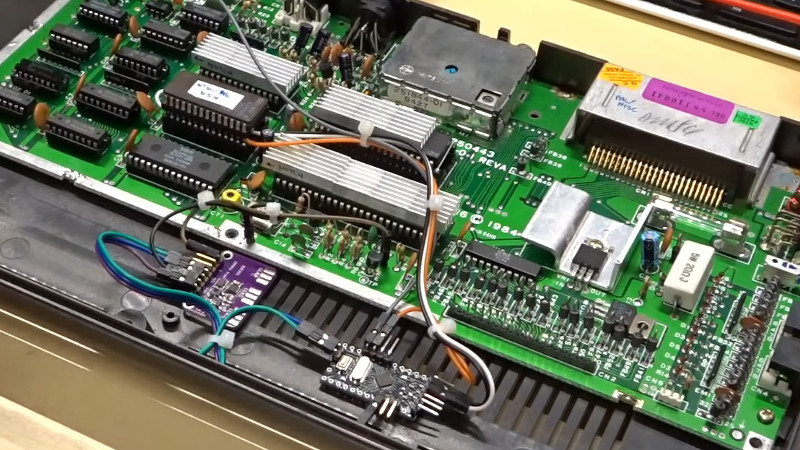We’re used to our computers being powerful enough in both peripheral and processing terms to be almost infinitely configurable under the control of software, but there was a time when that was not the case. The 8-bit generation of home computers were working towards the limits of their capability just to place an image on a TV screen, and every component would have been set up to do just the job it was intended for. Thus when different countries had different TV standards such as the mostly-European PAL and the mostly-American NTSC, there would have been different models of the same machine for each market. The Commodore 16 was just such a machine, and [Adrian Black] has modified his NTSC model with a custom ROM, an Arduino and an Si5351 clock generator to be switchable between the two.
The differences between a PAL and NTSC C16 are two-fold. The clock for the video chip is of a different frequency, and the ROM contents differ too. [Adrian]’s machine therefore has a larger ROM containing both versions which are switchable via one of the upper address lines. A couple of tracks cut in the crystal oscillator circuit allow him to inject a new clock from the Si5351 module, and and Arduino controls everything. The appropriate ROM and clock are selected via a very simple interface, the reset button is captured and while a short press still resets the computer a long one switches the mode.
Despite having its principal engineer, [Bil Herd] as a colleague here at Hackaday, it’s sad that we don’t see as many Commodore 16s as we should. A recent feature showed a 64k C16, but didn’t make it into a C64.
Thanks [Ian Somers] for the tip.
















could have just de-soldered R7 & Q2 .. no need to cut traces.
They discuss it int he video and comments. He finds it easier to fix the cut trace in the case of removing the modifications than finding the de-soldered parts to re-install them.
Interposing another socket with a clock pin leg lifted is also mentioned.
Desolder the parts and tack solder them somewhere to store them inside the unit. Or just tape them to the inside of the case.
I would have injected the clock before buffer amplifier Q2, either by cutting the track between the oscillator and the base capacitor, or (preferred) by lifting the input side of the capacitor and connecting a flying lead. That would have been less intrusive.
Speaking of 8-bit computers and TV systems: I was a proud owner of an Atari 65XE and I have used it for many years, before I saw it could output colors… The monitor I had was monochrome, as color monitors were practically unavailable (a few could be had at exorbitant prices) and TVs available in Eastern Europe were all SECAM, not PAL.
A good hack!.
Quite a few years ago, I gave away my C16, Vic20, C64, C128, TRS80, XZ80, ZX81,VZ200, Amiga1000, Amiga2000, and Signetics 2650 system. Others I forget the types.
Also my teleprinter, first amp I ever made, some army radio equipment. I still miss them and wonder why I did it.
The Vic20 had quite a few mods and I’d made switchable cartridges. It was a fun time learning about this new tech.
Now we can do quite magic things, like with the Arduino and the Si5351 board that would have taken a great many chips, if it would have even been possible.
My latest board is using just the same chips, but as a “VFO” for ham radios that were crystal locked.
If anyone is interested, it is here…
http://www.sadarc.org/index.php/projects/
The C16 (or Plus/4) is one of the few 8Bit systems where you can do this hack since TED can be switched between PAL and NTSC by flipping a bit in on of its registers. Most other systems of that time, including the VIC-20, C64 and C128 have the TV system hardwired in the video chip, if you want to change it, you have to replace the video chip.
Even the Amiga was hardwired at the beginning, that changed with the 8372 AGNUS.
Little fun fact if you are in PAL country: If you want a really fast C16, disable the display, then switch to NTSC. That will give you an effective CPU clock of 2.2 MHz. You don’t get any usable video output though. I used this back then to speed up calculations. Heatsinks for CPU, TED and PLA are recommended. Also, replace the 7805 with a switching regulator and remove the large white 20 Ohm 5W resistor for a lot less heat inside the system.